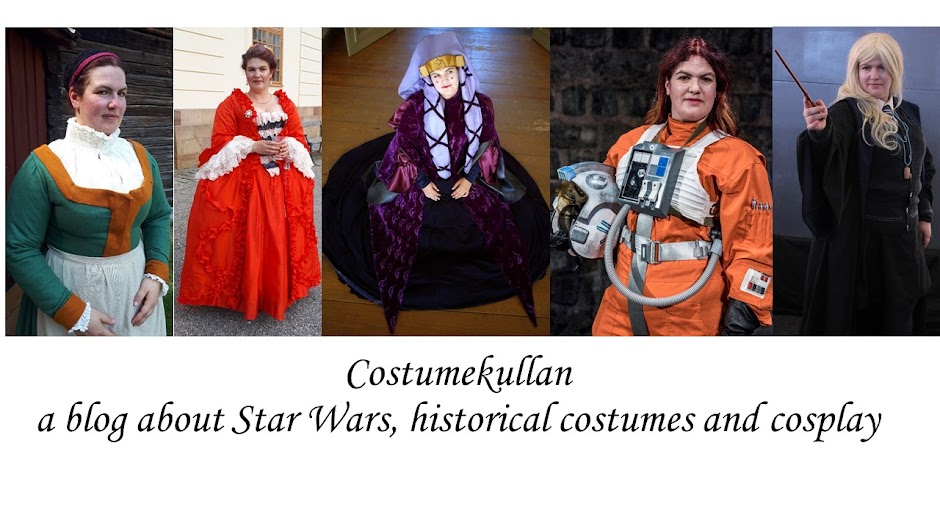Challenge 2: innovation To celebrate the way inventions, introductions and discoveries have
impacted fashion, make an item that reflects the newest innovations in
your era. Be sure to share the research you did on your innovation, as
well as your finished item.
Ok, so this is a bit of a stretch, but rather than just choosing an innovation that changed fashion, I found it interesting to see how the history of this thing has been affected by innovations. The innovation I chose to focus on was bobbin lace. The stretch is that I've chosen to use the innovation for an era around 200 years after it was invented.
First though some background and family history. In my stash I have many meters of lace, quite a few worn out pillow cases with lace and other bits of pieces with different kinds of lace and decorations on them. These come from my great grandmother on my father's side. My great grandparents were quite well off farmers, according to my father they were the kind of people who never spent anything unless necessary, and made as much as possible at home. My great grandmother was skilled in the crafts needed for woman taking care of proper household. . I can't be 100% sure, but I'm pretty certain that all these of lace are probably made by her, which would date them to the early 20th century.
Lace has been made since antiquity using just a needle. In the 16th century bobbin lace was invented. When doing bobbin lace you bound the yarn up on bobbins, hence the name, and then you twist and turn the threads in a pattern, the lace that is made is wound up on a lace pillow. With bobbin lace it was possible to make a lot more lace, and work a lot faster, than with just a needle. The fashion exploded with lace, and several regions in Europe came to be famous for their lace-making. This continued up until the early 19th century. Then the first mechanical lace machine was invented. At first this led to the bobbin lace makers only making their laces more and more complicated, since the early lace machines couldn't do too complicated patterns. In the end though bobbin lace was replaced by meters and meters of machine made lace. The bobbin lace retreated into a craft for women to do in their spare time, and the laces they made were not fine enough to put on clothing. Except for in folk costumes, the home made bobbin lace was no used to decorate things for the homes, table cloths, bedlinen and so on. This is where my pieces of lace come in, they are prime examples of this kind of lace decorated bedlinen to which the bobbin lace had been relegated.
For the HSF challenge I decided to make this bobbin lace return from the bedroom to the salon, so I've made a pair of flounces that I will be able to use with my 18th century gowns.
This is the piece that I wanted to use. It's a very soft fabric, I don't know if it's worn or if the fabric was this soft from the start. The piece has been cut up, probably to just save the lace at the end, there were also some small holes in the middle of the piece.
Here's a closer look on the lace. The piece, I think it's been a pillow case, is sewn with a machine and I can't help but wonder if it was made on the old treadle machine that I remember standing in a corner when I grew up. Today I would have loved if we had kept it, so that I could use it.
The piece wasn't very wide, just enough so that I could cut it in half to make the flounces. So I cut it in half on the width and then cut off the excess fabric on the top. I sewed it together to form a tube, and hemmed the top edge.
Here are the finished flounces. They are not something that I would wear to a very fancy gown, but they will do really nice with some of the more "casual" gowns. For now I've attached them to my anglaise of printed cotton.
Fabric: An antique pillow case with bobbin lace
Pattern: none
Year: 18th century
Notions: regular sewing thread
How historically accurate is it? Not very. Except for the lace itself it's all made by machine, and the pillow case wasn't wide enough to make very flowy and wide flounces. Still they do well to masquerade as 18th century pieces
Hours to complete: 40 minutes
First worn: never
Total cost: $0 - all from my stash






No comments:
Post a Comment